1937 – 1977
Keith Namatjira was sixteen when he accompanied his father, Albert Namatjira, to Canberra in early 1954 when Albert was presented to Queen Elizabeth II by Cabinet Minister Paul Hasluck. Two years later, in 1956, he accompanied his father to Sydney when they stayed at the home of film maker Frank Clune and his wife.
Keith was exposed intimately to the extremes of his father’s fame and honour in his formative teen years. Disaster struck when in 1958 and 1959 he was exposed to the distress of his father’s dramatic trial for supplying alcohol to an Aborigine, imprisonment at Papunya and death in Alice Springs hospital.
Minister Paul Hasluck insisted that if Albert was imprisoned, he would serve the term not behind bars in Alice Springs Prison, but in his own country in the open. Papunya was declared a prison for the purpose. Keith appears to have spent much of his time living in Papunya, which is in his mother Rubina Namatjira’s family’s country. However from 1959 Papunya was experiencing the upheaval of Pintupi incomers who had been forcibly removed from their traditional country out west and effectively dumped in this settlement being constructed for the enlarged population.
Somehow, Keith matured into a man of considerable intelligence, patience and sensitivity during these events. In this period he must have made some efforts to paint as he created an accomplished painting in 1959, his first known serious painting.
In his glorious painting of 1959 he honoured his father’s achievement in his father’s style. Then in the 1960s he turned to combining the aesthetics of the Hermannsburg School with traditional influences to suggest the sensation of place pictorially. From the late 1960s Keith gently showed a pathway between the view point, through the country portrayed, to the totemic site which was the subject of a composition. In another scene all parts of the country portrayed seem intimate and the viewer is welcome to enter. This correct pathway became more emphatic from 1972. In 1973, however, the viewer is not invited to a harsh scene.
Finally Keith reflected on a social and cultural dissonance between Hermannsburg and Papunya, perhaps himself and Papunya. He seems to have demonstrated and resolved that the Hermannsburg style in painting the appearance of the country is in itself a screening strategy. He was accordingly mindful of the subtle Hermannsburg style aesthetic gestures that show respect for totemic country, such as the token screening of a totemic hill at its base with small trees. Keith was of the Hermannsburg Mission culture, lived part of his life in his mother’s country of Papunya (albeit in the Mission’s distant area of influence), and lived and died in the town camp culture of Alice Springs. Keith was a respectful man and a realist.
Although he was not prolific in his short life, Keith was a master painter of the Hermannsburg School.
Wenten Rubuntja and Clem Abbott also adopted this pathway device during this period. Other painters suggested respectful approaches to the loved country.
Although his mother Rubina was of the Kukatja people, Keith was raised mainly in the Western Arrernte culture of the Mission at Hermannsburg and the accompanying Hermannsburg School pictorial approach to landscape. Keith was a thoughtful, sensitive and important painter who gave some visual expression to his perceptions. His observations of the differences between the Hermannsburg and Papunya approaches seemed ‘matter of fact’ and not judgemental.
Keith’s 1959 painting is upbeat and in his father’s style. In the 1960s he asserted his own innovative approach when he decorated a composition at the Olgas with a traditional dot and line system. Until the mid-1970s his washes were clear and lemon was important. The late paintings include subdued, possibly downbeat, washes.
Figure 21.7 is particularly interesting because an upbeat Hermannsburg School style foreground sits in front of a muted but transparent Papunya approach, which includes dots partially masking the two important red hill tops, and entirely covering the hill bases (an exception in Hermannsburg art).
According to Geoffrey Bardon, Keith lived in Papunya at the time the Western Desert Painting movement commenced and had declined to join the traditional artists (apparently because he felt less traditional than the Papunya artists). It is touching that Kaapa Tjampitjinpa named his son ‘Keith’. They apparently knew each other with personal and respectful warmth. Keith was not a prolific painter and, sadly, died young.
Keith was born when his father Albert Namatjira was 35 years old and his mother Rubina was about 34 years old. Keith was Western Arrernte, Subsection (Skin) Peltharre. Keith married a Loritja woman, Lilly Namatjira Tjantjingu, born 1936. Lilly was the daughter of George Tjangala (Register of Wards Hermannsburg 1957 p 25).
Alice Springs town camps had attractions for the Hermannsburg artists. On 30 June 1966 Keith was at Number 2 Artists Camp Alice Springs. Keith was camped with Lindsay Ebatarinja (Imbarndarinja), Gabriel Namatjira, Benjamin Landara Ebatarinja, who was married to his sister Maisie. Keith’s wife and children were at Hermannsburg (as were the families of Gabriel and Benjamin. Keith died in Alice Springs.
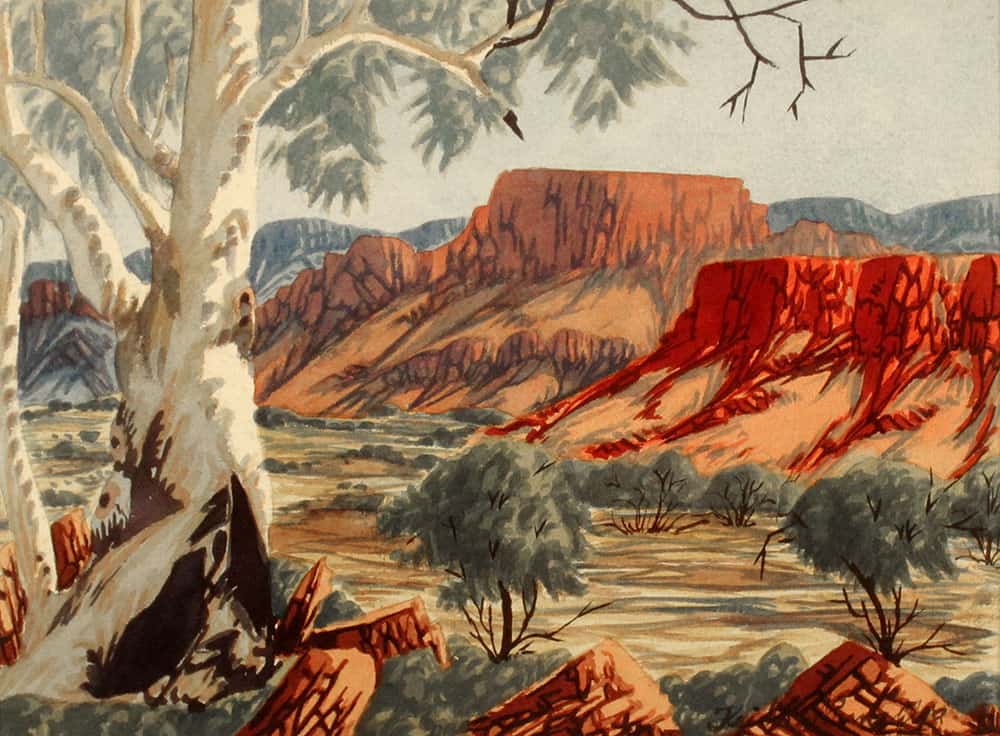
MacDonnell Ranges
Keith Namatjira
• • •
1959
Watercolour on paper
25 x 34.5 cm
Beverley Castleman Collection
BDC-KthN-11
This glorious painting from the sad year of Albert’s imprisonment at Papunya and death at Alice Springs hospital seems to celebrate Albert’s life and work and perhaps to assert Keith’s own ability to paint like Albert. It has a firm sense of design and structure employing a sophisticated system of colour. A light breeze flutters the leaves of the mid-ground trees. This is the earliest painting by Keith found in this research.
Flat cobalt blue sky and two tone distant hills. Sophisticated use of alizarin crimson, greyed with ultramarine. Yellow ochre colour pale on plain. Some large pointy geometric reddish rocks in front completing a screen with green ground cover blob vegetation. Light green behind big tree foliage. White of trunks is unpainted paper. Big tree and screen frames the view of red hills. Lemon under wash on rear plain, yellow under-wash on front plain. Dot and line infill on rear plain. Line and blob trees with fine black trunks on front plain.
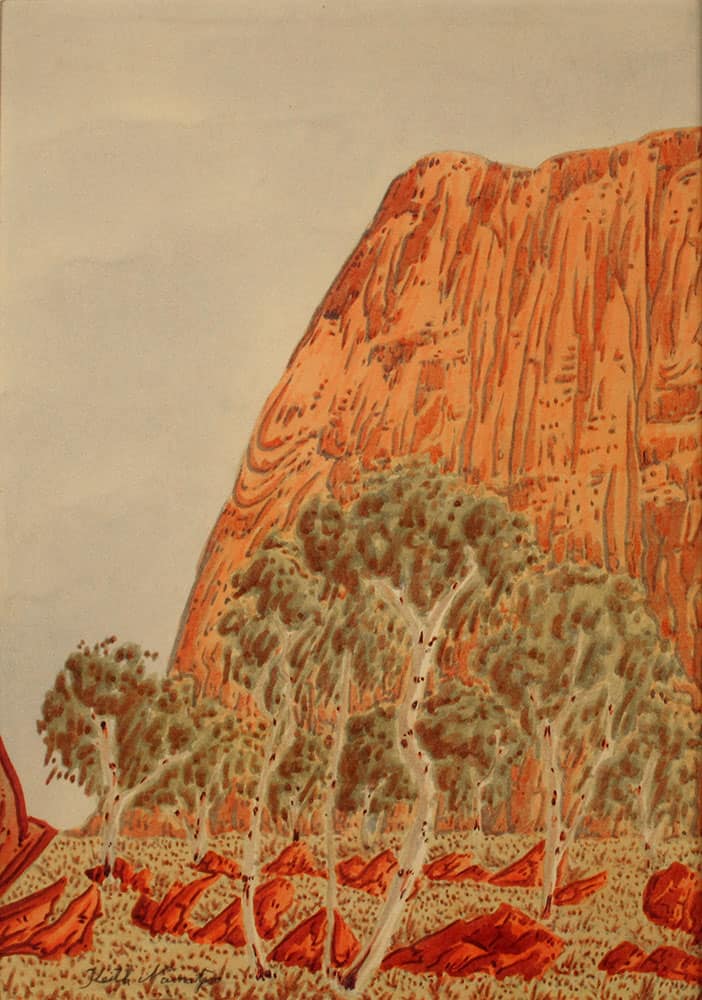
Valley of the Winds, The Olgas
Keith Namatjira
• • •
est. 1960-69
Watercolour on paperboard
35 x 25 cm
Beverley Castleman Collection
BDC-KthN-05
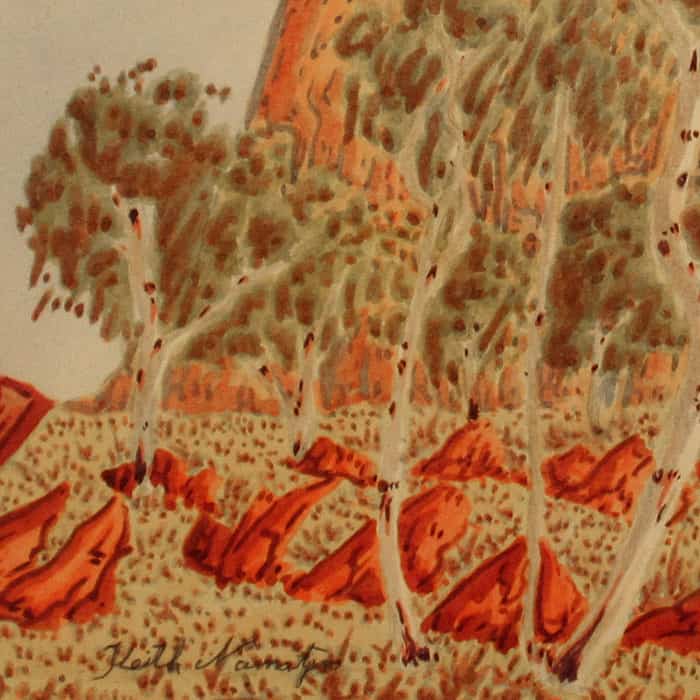
Trees which are quivering in a warm breeze and bright light, standing among lively red rocks and on a field of speckled yellow trigger a memory of the author’s visit to this iconic site. The profile of one side of the iconic rock confirms the location, namely Kata Tjuta/The Olgas.
This innovative painting celebrates Keith’s capacity to adapt his style to impart the experience of this place.
Keith flattened the picture plane to reduce the sense of distance, while adapting traditional practices of dotting to achieve affect in his non-Aboriginal audience. He continued to include parallels to underpin the design.
This interpretation of a site well south of his traditional country shows an increasing awareness of Keith’s aboriginality. Keith has shown how this country looked in a way recognisable by non-Aboriginal minds, while asserting his general cultural pride and roots. He respectfully refrained from using too much detail in this country to which he had no traditional entitlement. He has decorated the composition in Aboriginal secular ways of decoration as used on implements, featuring parallels and dots. Perspective is flattened and there is no distance suggested in the blank blue sky. There is no plain in the distance. The orange side of the Olgas is infilled with parallel lines, straight and curved, and with dots. Likewise, the trees are decorated with dots and foliage is suggested with blobs and dots. The area in front is made luminous with the lemon dotted plain with crimson. This flat area of lemon with dotting was a characteristic which Keith developed further in his career.
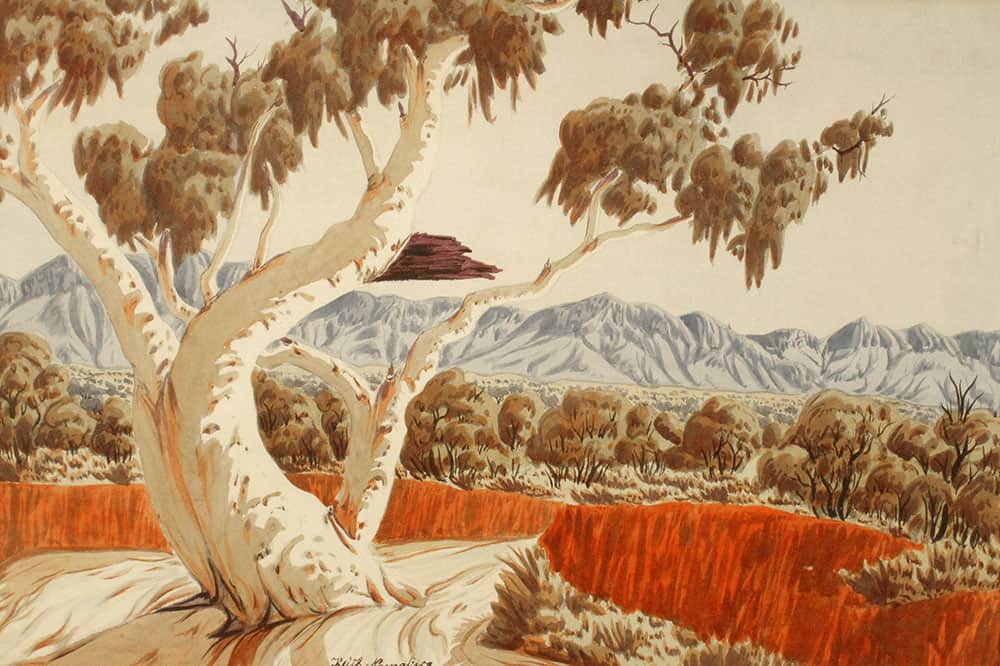
Ghost Gum at Finke River Bank
Keith Namatjira
• • •
1969
Watercolour on paperboard
34 x 51.5 cm
Beverley Castleman Collection
BDC-KthN-06
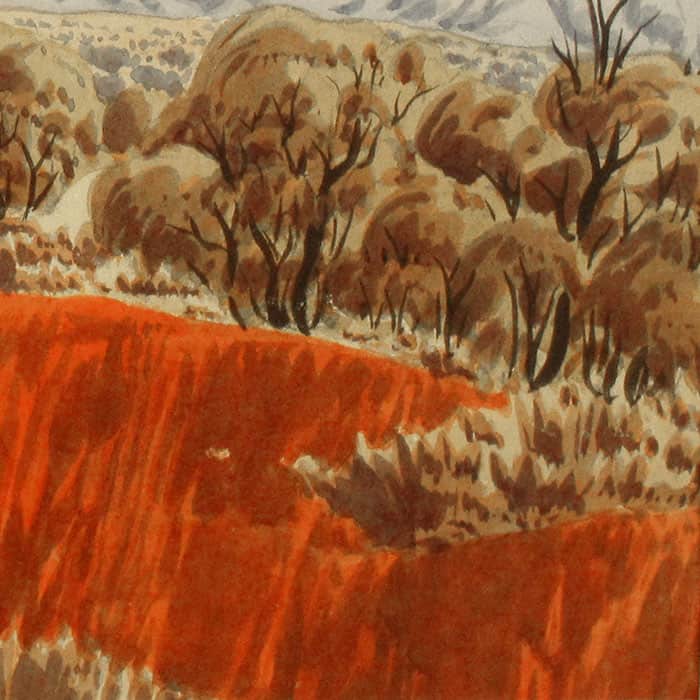
The elaborate tree near Hermannsburg is the major player against the horizontally patterned backdrop of the vertically patterned riverbank, treed plain, distant hills and bland sky. There is a gently suggested walkway from the foreground bank between the red riverbank and small trees to the area beyond.
This sophisticated composition of large horizontal areas is united by the elaborate curved big tree. Cobalt blue sky and two-tone distant hills. Horizontal lemon plain infilled with small dots at the back, blob trees across middle of picture and then grass gestures across front of band of blob trees. The red bank forms a band across the picture, with almost vertical parallel lines over-painted. Lemon/green backlights big tree foliage. The tree is lit from low right for dramatic effect.
Museum and Art Gallery of the Northern Territory has a painting by Oscar of the same scene in the same year; perhaps the brothers painted together. (Oscar NAM-0214, Museum and Art Gallery of the Northern Territory, 1969).
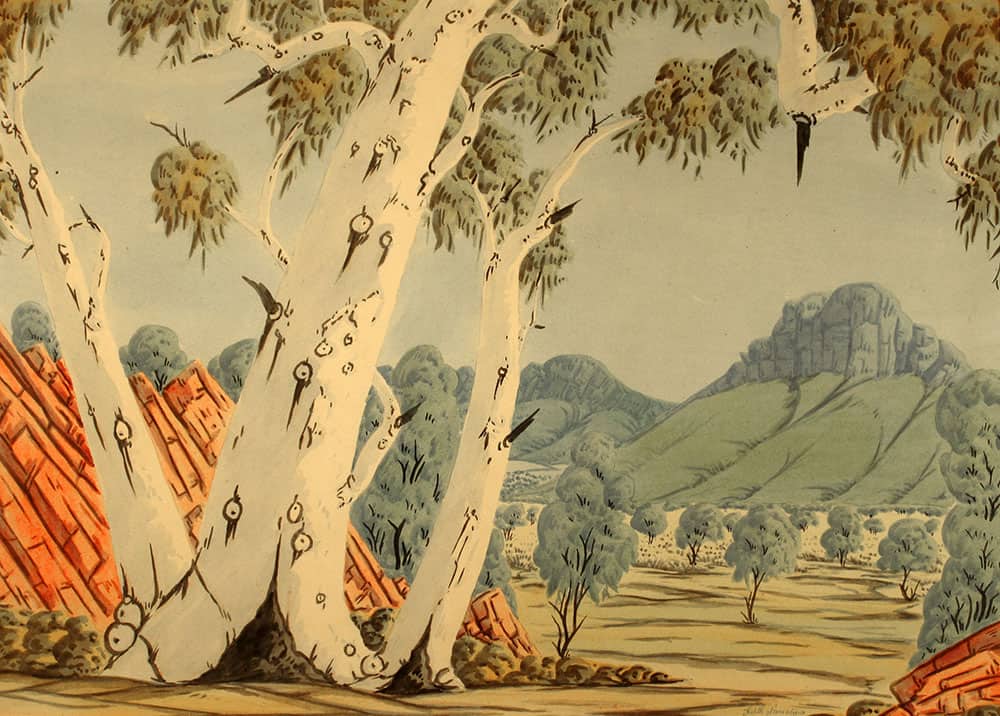
Ghost gum
Keith Namatjira
• • •
est. 1970-74
Watercolour on paperboard
50 x 70 cm
Beverley Castleman Collection
BDC-KthN-03
The detailed red rocky outcrops with the old ghost gum front and partly screen an intimate but large space of the treed plain, backed by distinctive hills. The foreground merges with the plain in this very careful painting and the same yellow on the rear of the plain is finely dotted. The viewer is invited to imagine wandering freely. The colour palette is of cobalt blue, lemon, pale crimson and black, with white of the tree trunks being unpainted paper. Geometric pale crimson rocks based on parallel, probably nature based patterns. Dark lines on red rocks, black line work on mid-ground blob trees, and big tree spikes, lines, circles. Lemon behind big tree foliage, which is blobbed with dark line brush strokes over. Prominent lemon plain. This beautiful painting is slightly faded.
By 1972 Keith started to indicate proper pathways into country. Gum Tree in the MacDonnell Ranges, 1972. (watercolour on paperboard; 37.5 x 27 cm; Signed lower right: Keith Namatjira. Museum and Art Gallery of the Northern Territory NAM-0210). Here, the lemon dotted plain seen in Valley of the Winds, The Olgas, est 1960-65, includes a smooth orange/red area, which became a path for a viewer to ‘stroll’ in later paintings.
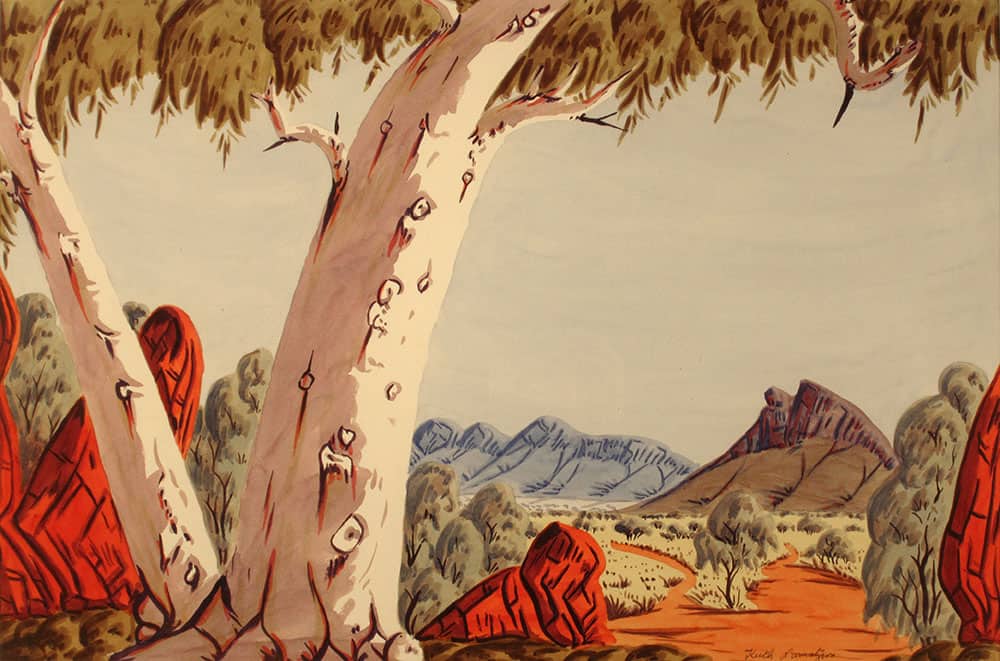
Near Hermannsburg
Keith Namatjira
• • •
1974 (verso: November 1974)
Watercolour on paperboard
35 x 52 cm
Beverley Castleman Collection
BDC-KthN-02
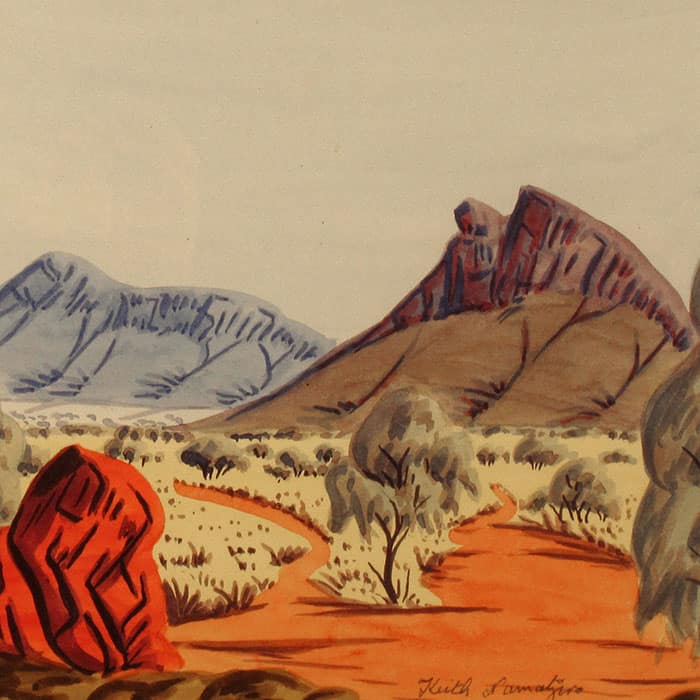
The viewer can see a twin-peaked iconic hill at right of mid-distance, but the country to the left is screened off from sight by a screen of fantasy red patterned rocks and the foliage of small trees. (The location is apparently in the Belt Range south of Papunya). A gap in the low screen invites the viewer to contemplate a walk into the scene on a smooth orange-red earth area.
The red earthen area divides into two emphatic paths, one curving toward the twin peaks and the other to an undisclosed destination around to the left behind the left foreground scene. The large ghost gum on the viewer’s side of the screen perhaps hints to the existence of two worlds, one behind and one in front – the latter of which the viewer belongs. [similar commented to John Kean 22.3.15]
Keith and Wenten Rubuntja may have influenced each other in showing pathways on which to walk to special sites.
This is partly a fantasy and is in vibrant colours. Tall crimson rocks help frame scene in front of blob foliage mid trees. Three quarters of the lower edge is screened with low round vegetation. Large tree framing the scene is in front. White of trunk is unpainted paper. Shaded side pale mauve. Blob and dot infill, representing trees on yellow plain. Lemon behind foliage of large tree, which has dark brush strokes. Black, red and yellow line work on big tree, rocks and mid ground.
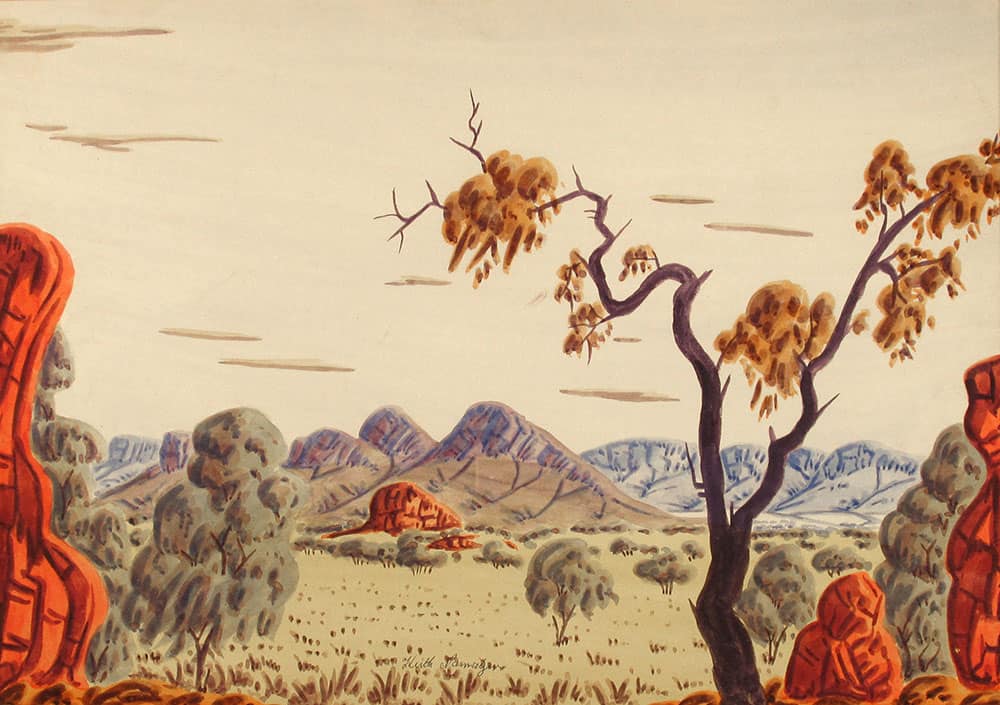
Central Australian Gum Tree
Keith Namatjira
• • •
est. 1973-75
Watercolour on paperboard
33.5 x 47.5 cm
Beverley Castleman Collection
BDC-KthN-10
The emotional mindset of this expressive scene is quite unsettled. The big black tree has almost lost its battle to survive. Small trees live on the harsh lemon plain, which does not seem to entice the casual stroller to enter. [Commented to John Kean 22.3.15] No pathway for the viewer is suggested.
This is an emotional memory painting. The big black trunked tree has struggled to regenerate and is losing the battle. The style of the black tree and the prominent clouds may have been influenced by Kaapa Tjampitjinpa, or vice versa. Kaapa also lived in Papunya and was a founder and leader of the Western Desert art movement. The hills, rocks and trees are rounded, but the big tree is spiky with deep purple silhouette with unreal yellow orange blobs for dying foliage.
A pale blue sky and two tone cobalt blue distant hills with muted mid-ground hills provide the backdrop for the harsh scene.
The intense lemon plain from hills to foreground has infill big dots at back for blob trees, small dots toward front and tussocks. On each side of the foreground animate crimson tall rocks seem to blinker the view. The flat clouds overhead add to the unease. Low orange ground cover each side – rounded. There is strange and dark foliage on the silhouette tree. Red rocks look animate.
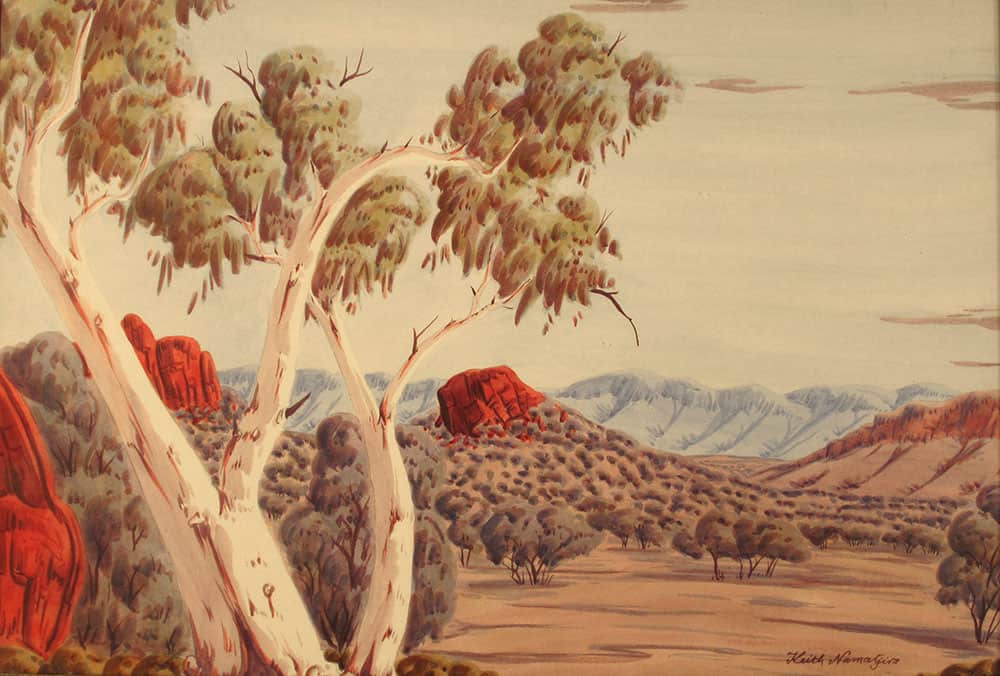
MacDonnell Ranges
Keith Namatjira
• • •
est. 1974-76
Watercolour on paperboard
33.5 x 51.5 cm
Beverley Castleman Collection
BDC-KthN-09
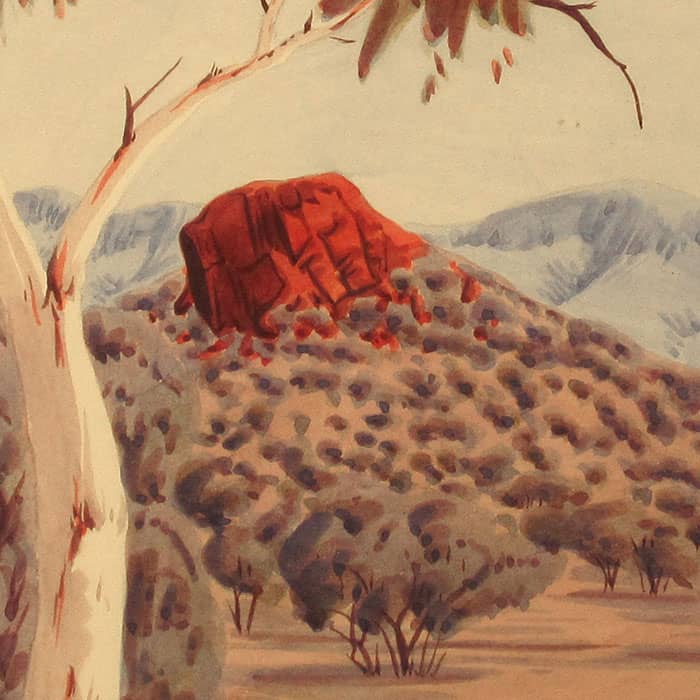
Keith adapted Papunya style dots over part of the red cliff-tops of totemic hills, which although the dots can be read as trees on the hill bases, cannot grow as painted on the red cliff-tops. Perhaps Keith was hinting that sacred caves and tjurunga may be in the red cliffs. Thus they seem to the author to be a reference to a Papunya artists’ alleged practice of screening sacred symbols from the public view by applying dots over the symbols. The hills in turn are ‘screened’ by a ‘Hermannsburg style’ large ghost gum.
The clear colours are in the red totemic rocky hill tops and the large red rock at left foreground and the lemon in the foliage of the ghost-gum. The muted greys of the plain and the dotting suggest a down-beat attitude. The painting seems a wistful contemplation of the landscape practices at least at Papunya. Keith lived through the elders’ objections of 1972 and 1974 about ‘too much’ being revealed. From his detribalised perspective he painted appearance of the totemic landscape without saying ‘too much’.
Red totemic hills may be travelling to left. The left trunk of the tree emphasises the movement, while the right trunk resists. The big tree is a ‘Hermannsburg School’ type of screen; dots are a symbolic Papunya screen. This is the only example of dots obscuring cliff tops in the author’s collection. The dots are apparently screening lower part of red outcrops, as least symbolically. Dotting on plain appears decorative and screening and infill. Stripes indicate the foreground. Dots, blobs and lines unite painting. The only yellow in the painting is on the narrow foreground supporting the big tree and also in the yellow back-lighting of the big tree foliage. The tree and foreground are upbeat along with the red outcrops, which are being partly screened by dots. The plain and dot screen are downbeat.
